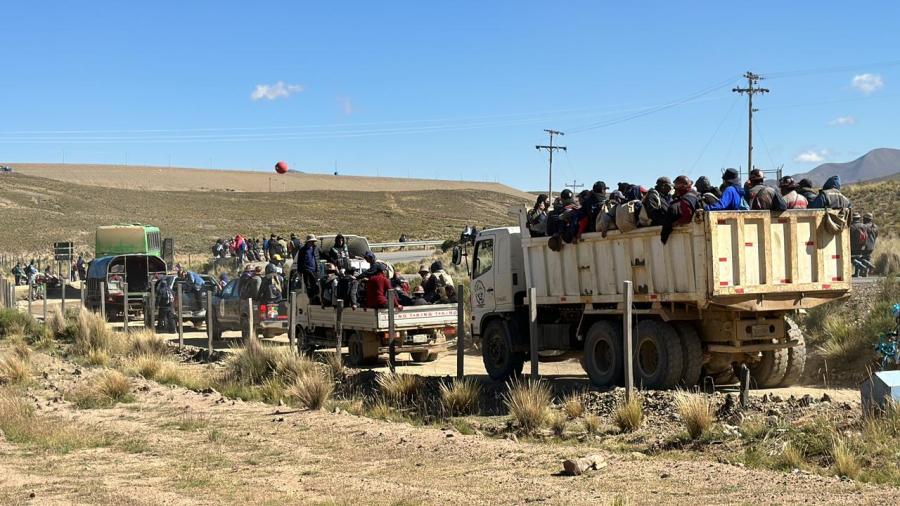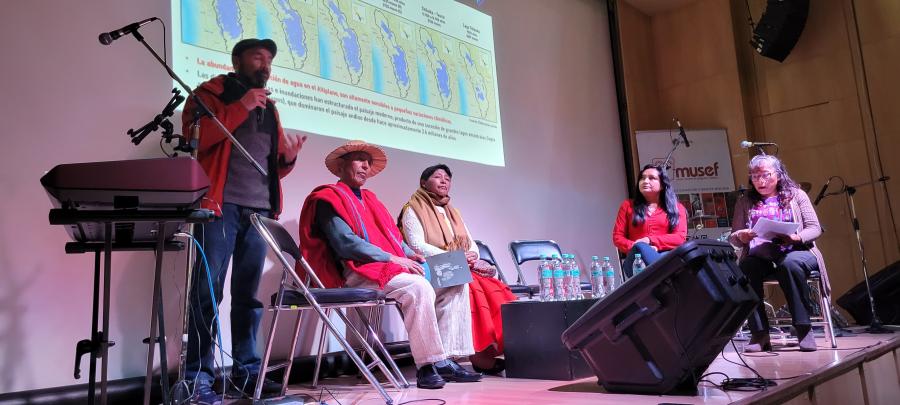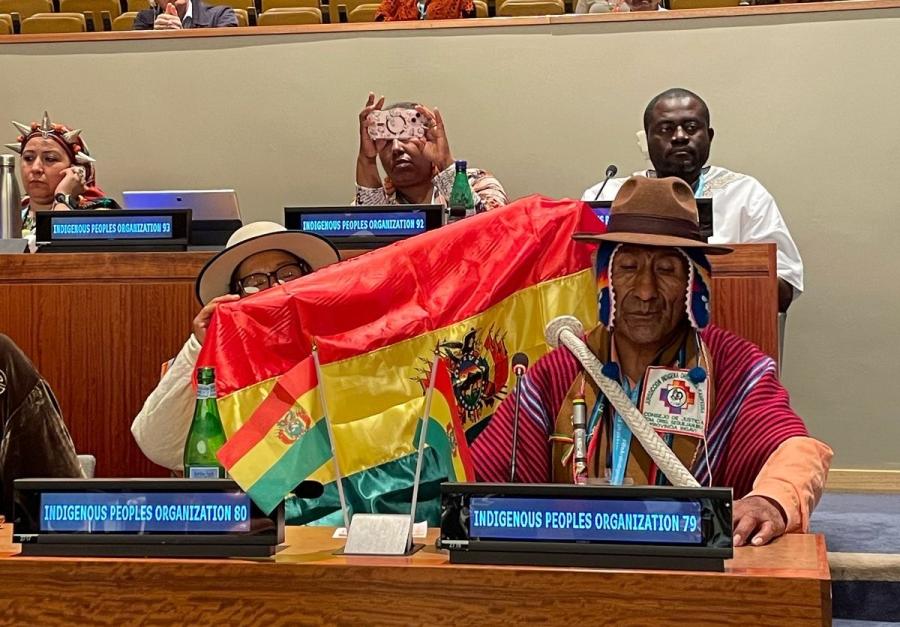Geomatics and Political Empowerment: The Yuquí "...that master tool,. geography's perfection, the map."
Geomatics, a new term covering the rapidly evolving types of equipment and applications designed to capture spatial information, have gone far beyond the making of maps. Advances in the technologies behind Global Positioning Systems (GPS), Geographical Information Systems (GIS), and Remote Sensing have allowed for new applications that range from the simple storage and manipulation of spatial data to sophisticated analysis and advanced modeling. Examples of advanced applications include merging satellite imagery from different time periods in order to detect environmental change, and incorporating these images into a GIS database updated by GPS to allow for the monitoring of development encroachment.
Cooperative efforts among the major players in geomatic technology development such as Environmental Systems Research Institute (ESRI), ERAS (previously Earth Resources Data Analysis Systems) and Trimble Navigation have allowed for a more seamless integration of data through joint product developments and the removal of proprietary barriers to data exchange, which further increases the scope of future uses. This integration reduces the learning curve necessary to apply the technologies to problems in the field, and increases user accessibility by lowering the cost of equipment and training. The map has become a mere by-product of this expanding capability in a technological environment, yet it remains a powerful resource in the struggle to help empower indigenous peoples around the world. In the midst of confrontation and political turmoil, the map is often an island of calm and reason that helps validate their side of the story,
Lowland Bolivia is one of the many areas where this struggle for indigenous land rights continues. Under intense scrutiny by the international conservation and advocacy community and facing mounting political pressure at home from local indigenous organizations. President Jaime Paz Zamora signed a number of Supreme Decrees between 1990 and 1992 delivering over 830,000 hectares of territory to several indigenous groups. (Jones, in press). While the government's willingness to recognize indigenous land rights is encouraging, no provision was made for the funding of land demarcation or mapping, and no legislation was passed to protect the territories from invasion by settlers, loggers, miners or oil companies.
This same intense scrutiny and political lobbying by conservation and advocacy groups has been instrumental in causing fundamental policy changes in the leading requirements of the multi-lateral development banks. As a result, when a highway construction loan was negotiated between the Inter American Development Bank (IDBI) and the Bolivian government, a portion of the funds was earmarked to be used for mitigating the negative social and environmental impacts of the bank-funded road development project.
The Yuqyí were one indigenous group identified by the Bolivian government to receive a territory and also targeted by the IDB to receive development funding. During preparation of the documents necessary for establishing the territory, five years of anthropological research data were presented as evidence of the need to increase the original government offer of less than 50,000 hectares to over 100,000 hectares, and to utilize natural river boundaries wherever possible in determining actual territorial boundaries (Stearman, 1994). The Yuquí, who were on the brink of cultural extinction, were granted 115,000 hectares on April 9, 1992, and were selected in part because of the exigency of their situation. Prior to contact by missionaries in the mid 1960's, the Yuquí were one of the few remaining hunting-and-gathering peoples in the world. They were true foragers, depending only on the resources of the forest they inhabitated for their livelihood. They moved almost constantly in their pursuit of game, fish, honey, fruit, and other foods necessary for subsistence. At the time of contact, the first of three bands, all of which were eventually settled at the mission station on the Chimoré River (16°47'S, 64°56'W), numbered only 43 people (Stearman, 1989). With natural increase and the addition of two more groups contacted, the Yuquí population has now reached almost 150.
At present, the Yuquí are sedentary and practice some agriculture, but they continue to depend on foraging for much of their dietary intake. Unfortunately, they are located in a region of Bolivia that is being settled by colonists from the highlands who are seeking new lands to farm. With settlers encroaching on their foraging territory and competing for many of the same resources, the Yuquí find it increasingly difficult to feed themselves Unlike many indigenous groups with an ancestral homeland and a fairly strong sense of cultural identity, the Yuquí had become geographically isolated on land not of their choosing, with the fabric of their traditional culture being slowly unraveled by acculturation.
The challenge in working with the Yuquí was not only to operationalize the demarcation and mapping of their territory, but to help rebuild their fading sense of identity and the internal strength it provides. The initiation of the broad-spectrum. Yuquí Ethnodevelopment Project included land demarcation as a primary objective, but also included objectives such as vocational training, health care and bilingual teacher training, development of a health clinic, school, community center, agricultural training, construction of new housing and potable water supplies, the development of a women's group, the establishment of a Yuquí Council, and leadership training. The broad scope of the project translated into limited financial and human resources with which to achieve each individual objective, which in turn was fundamental to the selection of geomatic technology as a cost-effective alternative to traditional survey and mapping techniques.
The Yuquí territory is a triangle-shaped area located between 64°30' and 65°15' west longitude, and between 17°00' and 16°10' sough latitude. This triangle lies entirely within the Amazon basin at an average altitude of 250m, and is within 60km. of the eastern edge of the Andes Mountains. The territory is bound on the west by the Chapare River, on the east by the Uchilo River, the southeast by the Uchilo River, the southeast by the Ivirgarsama River and on the north-northeast by the Useuta River. These rivers are all tributes of the Mamoré-Madiera river system whose western and southwestern headwaters reach all the way to the eastern cordillera. This river system is the Amazon's largest tributary at 3200kms., and is the 14the longest river in the world.
The primary ground cover is tropical rain forest, with the average rainfall being 4000-5000mm per year. The rivers are numerous and shallow due to the low gradient of the land causing channels to shift and leaving a trail of oxbow lakes, sloughs, large marshy areas, and ponds. They are classified as degrading upper Amazon while water, characterized by wide beaches and steep muddy "cutting" banks, and often carry a huge volume of storm water from the Andes that turns them into raging torrents of brown silt with massive log jams. From the air this sprawling complex of forest, river, swamp and lake looks like an impenetrable canopy of green, laced with meandering rivers. The rugged and remote nature of the territory was the second determinant in the decision to utilize geomatics as the methodology for land demarcation.
The first step was to collect the only freely available maps of the region in order to construct a base map to guide fieldwork and to present to the community. These consisted of seventeen-year-old 1:50,000 topographical maps done from aerial photography, and provided the beginning of a timeline form which to monitor change. These maps were placed in the community center along with the Supreme Decree granting the Yuquí their territory, and the new territorial boundarie were drawn in during a meeting of all Yquí to initiate the demarcation process. Individual Yuquí Council members, then accompanied Project personnel on an aerial survey to identify the key corner of the territory as well as to gain a sense of the current level of settler occupation, logging activity, and the degree of flooding. This survey was videotaped, and shown to all the Yuquí in a second community meeting. The videotape of the over flight remains with the Yuquí Council.
A Trimble Pathfinder Basic GPS unit was utilize in the boundary demarcation for both navigation and data collection. GPS works by using a form of triangulation based on multiple satellite radio signals to determine geographic location, and then stores this positional data along with any use-defined attributes for importation into a GIS database. The Trible GPS was chosen for a variety of factors, including ARC/INFO GIS compatibility, lower cost of educational institutions, an extensive international support network, and excellent training opportunities. Financial constrains and the inherent inaccuracies of eroding riverbanks as territorial boundaries did not warrant the additional expense of a base station for differential correction. That level of accuracy was deemed inappropriate for the specific location and adjoining land uses. The mapping of the territory proceeded over the next three months and was accomplished primarily by boat. One of the strategies behind increasing the size of the Yuquí territory in addition to acquiring adequate land for sustainable foraging was to provide as many natural boundaries as possible. It is far easier to defend a river boundary, one that is determined naturally, that it is to maintain a trail that overgrows in just a matter of weeks. The rive boundary may shift form year to year, but its visibility far outweighs the inconvenience of having to move or replace boundary monuments. In terms of having to ground-truth a map (the process of locating specific geographic positions or attributed in the field), and then place markers along boundaries, a river presents an open and navigable waterway whereas having to cut trail is time-consuming, difficult and expensive work that requires an enormous output of labor.
One of the limitations of using a GPS unit has having enough open sky overhead to receive satellite signals. These conditions, however, normal exist on larger rivers. By using the Project boat with its 40 hsp motor, two of the three sides of the triangular-shaped territory were mapped by setting the GPS antennae in the prow of the boat and then simply running the rivers. By using the Project boat with its 40hsp motor, two of the three sides of the triangular-shaped territory were mapped by setting the GPS antennae in the prow of the the boat and then simply running the rivers, often a full speed, as the unit automatically recorded and stored latitude and longitude positions. Boundary comer monumentation was accomplished by painting large trees with white paint and then affixing an aluminum sign with the name of the Yuquí territory printed upon it. Each of these expeditions include a member of the Yuquí Council who participated in locating and marking monuments and was able to familiarize himself with the actual limits of the territory (Jarvis. 1993).
The most difficult part of the demarcation process involved the southern boundary, which was an artificial line that formed the base of the triangle and had to be opened through dense rainforest and swamp. The entire Yuquí community participated in this effort, working in shift a over a period of several weeks. The southern boundary lies near the newly paved highway an intersects a zone of intense colonist activity, therefore presenting the greatest demand for constant vigilance. Two camps were constructed along this trail to encourage the Yuquí hunters and their families to use the area more frequently. This strategy served not only to reduce hunting pressure on the core area around the mission settlement but also to maintain settlement but also to maintain constant Yuquí presence in the southern boundary sector. These camps also served as rest spots for the three Yqyuí forest guards who would patrol the area on a monthly basis.
This issue of territorial security and boundary enforcement underscores one of the possible constraints present in mapping indigenous lands. National governments, even if committed to indigenous land rights in principle, are more concerned with matters of national security and military enforcement of national policy. Bolivia is one of the world's major cocaine producing and exportation countries, and the Yuquí territory is in the military designed Red Zone of illegal activity. This zone is heavily monitored and controlled, adding a real element of danger to any civilian activity.
These internal security concerns make the task of locating current maps and of identifying national mapping standards and conventions extremely difficult. National mapping projects and map access are often controlled by the military. An intensive lobbying effort was latitude between Project personnel and the Bolivian military mapping agency in order to gain access to current maps of the region in which the Yuquí territory is located. Map quality and availability is often difficult at best in many developing countries. Working with the military is often necessary in assuring that the most current geographical data is obtained, and that national level political realities are acknowledged.
Following these negotiations, a current set of maps of the region produced by the Bolivian military from aerial photography were obtained. As the Yuquí began to physically take control of their newly demarcated territory, the process of building a comprehensive GIS database was begun utilizing ESRI's "ARC/INFO" software package. The software is the heart of a GIS, which is a relational database that links attribute data to spatial data for manipulation, analysis, and graphic display. The value of a GIS database resides in its ability to house data from a variety of different source, but the process starts by establishing a common denominator to which all future data will be registered. A GIS database is only as good as the data with which it is constructed, and the acquisition of current maps and their production parameters became of paramount importance to the completion of the project.
The most recent panchromatic satellite imagery available was acquired from the French space agency, Center National d'Etudes Spatiales (CNES). Their U.S. distributor SPOT (Satellite Pour L'Observation Terre) Image Corporation, named after the SPOT 1 satellite, offered the highest resolution and largest selection then available in the marketplace. The image was rectified using ERDAS' image processing software, with ground control points selected from the military maps and the GPS ground survey. Roads and land development were digitized from the current topographical maps, and those vectors were overlaid onto the satellite image. With several years' time difference between the two datasets, new development and other environmental changes that threaten the Yuquí territory are readily apparent. Periodic acquisition of already georectified SPOT image photographic hardcopy with the same location parameters would allow for visual monitoring of the entire territory by the Yuquí Council through comparison with the existing map sets.
By digitizing all existing land cover forms into the GIS database, and then updating it by integrating a multi-spectral satellite image into the system with the same classifications, the database can be used in conjunction with the GPS to support a community forestry and integrated natural resource management plan. Forest resources can be identified and inventoried from the database, and then ground-truthed with the GPS. The accessibility of marketable species can be predetermined and river access points easily located. Potential harvest sites can be divided into plots to facilitate sustained yield management and to control for overcutting. Both of the above applications, however, require continued funding and technical assistance.
From the GIS database, Yuguí Territory maps were generated that identified not only the territory boundaries but land-maps were widely disseminated to international conservation and advocacy organizations, and distributed to the major government offices throughout Bolivia with one going to both President Zamora and to the newly elected President, Gonzalo Sánchez de Lozada. Small laminated maps were distributed to local and regional authorities, logging operations, and to the Yuquí community and placed in the care of the Yuquí Council, with large 3' x 3' wall versions of the map mounted in both the schoolhouse and the community center.
The YuguíEthnodevelopment Project was funded for 15 months, from May of 1992 to August of 1993, with the geomatics segment divided into roughly three parts over that time period. The first step in the process included the GPS survey, land demarcation, and map acquisition, which took approximately three months in the field. The second step, developing the GIS database and processing the satellite imagery, was accomplished over a 10-month period in the U.S. The final database delivery and the dissemination of the maps was concluded over a two-month period back in the field.
The larger issue, however, was establishing Yuquí credibility among local residents and regional authorities when it came time to confront people illegally extracting fish, game or timber from the territory. During the course of the project, several disputes occurred between the Yuquí and local loggers. Although tense at times, a major confrontation over a boatload of timber taken illegally from their lands resulted in the national government supporting the Yuquí right to confiscate the wood.
While the potential of the GIS database and satellite imagery is very real, the existence of the territory maps hold the most promise for the Yuquí. The maps signify authoritative institutional backing of the Yuquíterritory, and represent an enormous amount of political capital for a small indigenous group like the Yuquí. Participation by the Yuquí in the entire process, from demarcation to map presentation, was instrumental in developing a renewal sense of cultural pride and identity among the community.
Geomatics, a new toolbox of technology, has placed the symbolic tool of maps into the land of indigenous peoples. They are no longer invisible, the world can "see" where they belong. The map is a metaphor to tell us what we need to know, it speaks in a universal language that we all understand, and it is this new ability to communicate through maps that empowers the Yuquí. A map provides an integrating framework in which the total meaning is simpler than the multitude of smaller meetings that constitute it (Greemhood 1964). One may glimpse the meaning of an indigenous territory who Yuquí schoolchildren reverently touch their map - a map that tangibly acknowledges to them and to others their place in the world community.
Article copyright Cultural Survival, Inc.



